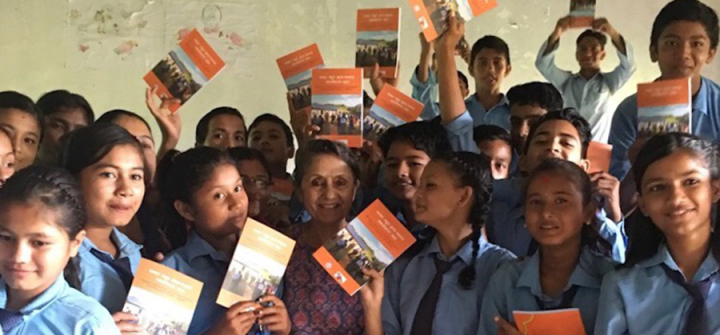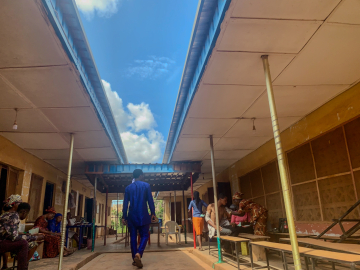The Lessons of Alma-Ata
Rita Thapa was in the room when it happened. September 12, 1978 in Alma-Ata.
The legendary meeting’s stirring call for primary health care for all reverberated across the ensuing 4 decades, leading to dramatic improvements in some countries and less success in others. Thapa, who represented Nepal at Alma-Ata, recalls the declaration as singular moment in her life and career. The physician, who founded the Primary Health Care Project in her country in 1975, has a unique view on the historic declaration and how it has shaped global health and policy in Nepal.
Thapa, who worked for WHO until 2001, will speak at a 40th anniversary event on September 12 at the Johns Hopkins Bloomberg School of Public Health. The event will be webcast. More info here.
You were in Alma-Ata in 1978, representing Nepal. What was the feeling like at the meeting and what did you hope would come from it?
Felt exhilarated. Deeply moved by Dr. Halfden Mahler’s call for health for all.
[The late] Senator Edward Kennedy’s address was electrifying. Still remember him saying something like, ‘you eradicated smallpox from the face of the earth. You did it by reaching every home of every village. So now you could reach everyone with primary health care.’ Nothing could have been more uplifting and more inspiring. I returned energized feeling ‘we can do it’—which I did and kept doing.
And how have things turned out on a global level 40 years later? Did countries deliver on the promise of Alma-Ata?
Many developing countries have tried PHC, making much progress in child and maternal mortality reduction and making [their countries] polio-free. But still we are far from the desired targets. However, Nepal is alone in South Asia achieving the health MDGs.
[We] had met early all the targets of Millennium Development Goal 4 on child mortality.
What’s Nepal’s secret for achieving this?
Mostly it is because Nepal built from the beginning the integrated District Health System with a countrywide network of more than 50,000-ward level female community health volunteers and some 4,000 village health workers, which reached a large number of clients at the community level with a proven set of interventions over a long period—thus bringing a striking and sustainable change in health.
One of the tenets of the Alma-Ata declaration emphasized the community’s say in how health should be protected, rather than a top-down approach. How has that community approach fared in Nepal?
Given the situation, Nepal’s score on this is pretty well. A countrywide network of female community health volunteers and Mothers’ Groups, linked with the country’s integrated district health system provides a platform for meeting [the] community’s say and that of top-down ideas, thus churning out sustainable health outcomes. A case in point … is that the maternal and child mortality rates continued to decline even through a decade-long internal conflict from 1996 - 2006.
Where do you see primary health care headed in the future?
As more people become assertive of their fundamental rights to health, which is universal and inter-dependent to several other basic rights, universal access to quality prevention, promotion, treatment, rehabilitation health care without financial hardship becomes a top priority public demand. In view of this, the 10 tenants of the 1978 Alma-Ata Declaration would serve as an important instrument to ensuring universal health care.
[For example], Nepal’s 2015 Constitution has enshrined basic health services, safe motherhood and women’s reproductive health, and children’s health as fundamental rights. To this effect, a Public Health Act, which is inclusive of the principles primary health care, is under discussion in the parliament. It would be instrumental to ensuring both public health and basic health care with no financial hardship to citizens.
Globally, the noncommunicable diseases are on the rise. Furthermore, there is the looming threat by the United States to women’s reproductive choice and children’s right to breastfeeding creating a ripple effect worldwide to reverse the progress we made together. In view of these realities, I believe, the momentum of primary health care could only be moving forward, even more vigorously and united in the future.
How have you put into practice the goals of Alma-Ata through your work with Nepal’s Primary Health Care Project?
Nepal’s Primary Health Care Project was born in 1975 in response to an imminent threat of resurgence of malaria. We worked on a war footing to establish a countrywide network of integrated district health offices, integrated health posts and linking them with mothers’ groups, and female community health volunteers within the respective communities. Over the time, Nepal has made impressive health [gains].
The average life span has increased from 40 to more than 60 years. Smallpox was eradicated in Nepal on 13 April, 1977. The total fertility rate declined from 6 children to 2.3 per woman—replacement level in urban areas; The contraceptive prevalence rate rose from zero to 43%. The maternal mortality ratio [per 100,000 live births] declined from a natural level of 1,500 or more to 239. Institutional delivery rates shifted from universal unattended home delivery to 57%: and the [number of] new HIV infections dropped by 82 % by 2015. I can go on.
You’re doing an intervention study that seeks to empower adolescents against cardiovascular and noncommunicable disease risks. What does that work look like?
The Bhaskar Memorial Foundation, an NGO, has started a movement called Bhaskar initiative for school heart-health empowerment studies (BISHES), in partnership of the ministries of health, education, public health experts, cardiologists, schoolteachers and students themselves. It attempts to experientially empower school adolescents, the largest and the most vulnerable population, against the 5 primary risk factors of cardiovascular diseases, [which are] the number 1 killer in Nepal and worldwide.
The science of the BISHES intervention is moving forward with fun and active participation of teachers and students in selected schools of all the 7 provinces. It hopes to bring changes in the 5 primary CVD/NCD risk behaviors among school adolescents, before and after the intervention.
You’ve been a public health leader in your country for decades. What are the most valuable lessons you’ve learned and what advice do you have for young people working in global health?
My take home lesson is never negotiate the evidence-based public health interest of people, no matter how hard it is. And accordingly transfer scientifically proven health technologies in a way that they are owned by local communities. Such [approaches] bring positive and lasting health outcomes, as I learned .
Ed. Note: This is the second installment of a Global Health NOW series on public health leadership.
Join the tens of thousands of subscribers in more than 100 countries who rely on Global Health NOW summaries and exclusive articles for the latest US and global public health news. Sign up for our free weekday enewsletter, and please share the link with friends and colleagues: http://www.globalhealthnow.org/subscribe.html
Physician-advocate Rita Thapa shares a booklet on cardiovascular disease risk factors with friends at a secondary school in Dang, Nepal on August 24, 2018. (Image courtesy)





